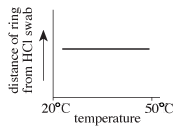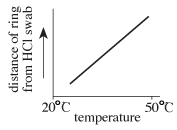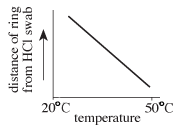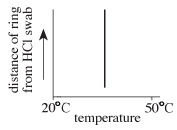Which of the following best describes how the 2 scientists explain how craters are removed from Europa’s surface?
Scientist 1:Sublimation
Scientist 2: Filled in by water
Scientist 1: Filled in by water
Scientist 2: Sublimation
Scientist 1: Worn smooth by wind
Scientist 2: Sublimation
Scientist 1: Worn smooth by wind
Scientist 2: Filled in by water
B. Scientist 1: Filled in by water
Scientist 2: Sublimation
Which of the following best describes the difference between the procedures used in Experiments 1 and 2 ? In Experiment 1, the:
temperature was varied; in Experiment 2, the diameter of the tube was varied.
diameter of the tube was varied; in Experiment 2, the temperature was varied.
distance between the swabs was varied; in Experiment 2, the temperature was varied.
temperature was varied; in Experiment 2, the distance between the swabs was varied.
A. temperature was varied; in Experiment 2, the diameter of the tube was varied.
In general, the results of Study 1 suggest that peony seeds that are placed in a petri dish containing damp paper are most likely to germinate when they are maintained at which of the following temperatures?
13° C
18° C
23°C
28°C
B. 18° C
According to Study 2, the thermal conductivity of rock salt measured at a temperature of 500°C would be closest to which of the following values?
1.0 W/m°C
2.0 W/m°C
3.5 W/m°C
4.0 W/m°C
B. 2.0 W/m°C
The information in Tables 1 and 2 supports the conclusion that Sample 3 contains:
Cu2+ and Cd2+ only.
Co2+ and Hg2+ only.
Ni2+, Co2+, and Cd2+ only.
Ni2+, Cd2+, and Hg2+ only
D. Ni2+, Cd2+, and Hg2+ only
According to the information provided, which of the following descriptions of Europa would be accepted by both scientists?
Europa has a larger diameter than does Jupiter.
Europa has a surface made of rocky material.
Europa has a surface temperature of 20°C.
Europa is completely covered by a layer of ice.
H. Europa is completely covered by a layer of ice.
Which of the following sets of trials in Experiments 1, 2, and 3 were conducted with identical sets of conditions?
Trials 2, 3, and 4
Trials 1, 5, and 9
Trials 4, 7, and 9
Trials 10, 11, and 12
F. Trials 1, 5, and 9
uppose another set of 25 peony seeds had been included in Study 2 and these seeds had a storage temperature of 25°C and a germination temperature of 18°C. Based on the information provided, the number of seeds that would have germinated after being maintained for 30 days would most likely have been closest to:
Individual Question
0
8
16
24
E. 0
According to Study 3, if another set of temperatures had been calculated for a time 1,000,000 years in the future, the calculated temperature increase in any of the 4 rock types would most likely be closest to:
0°C
10°C
20°C
30°C
E. 0°C
Based on the information in Tables 1 and 2, one can conclude that Sample 2 contains:
Individual Question
1 metal ion only.
2 metal ions only.
either 1 or 2 metal ions.
more than 2 metal ions.
F. 2 metal ions only.
With which of the following statements about the conditions on Europa or the evolution of Europa’s surface would both Scientist 1 and Scientist 2 most likely agree? The surface of Europa:
is being shaped by the movement of ice.
is covered with millions of meteorite craters.
is the same temperature as the surface of the Arctic Ocean on Earth.
has remained unchanged for millions of years.
A. is being shaped by the movement of ice.
Based on the results of Experiment 1, which of the following graphs best shows the relationship between the temperature and the distance of the ring from the HCl swab?
D. 
In Study 2, at the storage temperature of 5°C, as germination temperature increased from 13°C to 28°C, the number of seeds that germinated:
decreased only.
increased only.
decreased, then increased.
increased, then decreased.
D. increased, then decreased.
Welded tuff (another rock type) has a thermal conductivity of 1.8 W/m°C at 25°C. If measurements of the temperature of this rock type adjacent to SF canisters were taken as in Study 1, the recorded temperature would be closest to:
100°C
110°C
120°C
130°C
D. 130°C
Based on the information in Table 1, which of the following lists the metal ions in order from the fastest to slowest speed with which they moved up the paper?
Individual Question
Hg2+, Cd2+, Cu2+, Co2+, Ni2
Cd2+, Cu2+, Co2+, Hg2+, Ni2+
Ni2+, Hg2+, Co2+, Cu2+, Cd2+
Ni2+, Co2+, Cu2+, Cd2+, Hg2+
A. Hg2+, Cd2+, Cu2+, Co2+, Ni2
Which of the following statements about meteorite craters on Europa would be most consistent with both scientists’ views?
No meteorites have struck Europa for millions of years.
Meteorite craters, once formed, are then smoothed or removed by Europa's surface processes.
Meteorite craters, once formed on Europa, remain unchanged for billions of years.
Meteorites frequently strike Europa's surface but do not leave any craters.
F. Meteorite craters, once formed, are then smoothed or removed by Europa's surface processes.
If a trial in Experiment 3 had been performed with the swabs 25 cm apart, the distance from the HCl swab to the ring would most likely have been closest to:
8 cm
10 cm
12 cm
14 cm
F. 10 cm
Which of the following sets of seeds were exposed to the same conditions prior to being placed in the petri dishes?
Individual Question
The seeds from Study 1 that were stored for 8 weeks and the seeds from Study 2 that were stored at 5°C
The seeds from Study 1 that were stored for 8 weeks and the seeds from Study 2 that were stored at 15°C
The seeds from Study 1 that were stored for 10 weeks and the seeds from Study 2 that were stored at 5°C
The seeds from Study 1 that were stored for 10 weeks and the seeds from Study 2 that were stored at 15°C
G. The seeds from Study 1 that were stored for 10 weeks and the seeds from Study 2 that were stored at 5°C
According to the results of Study 1, which of the following best describes the relationship between thermal conductivity and rock temperature? As thermal conductivity increases, the rock temperature recorded adjacent to buried SF canisters:
decreases only.
increases only.
increases, then decreases.
remains the same.
E. Decreased only.
Based on the information in Table 2, which of the following figures best illustrates the appearance of the filter paper after Sample 1 was analyzed?
E. 
Scientist 2 explains that ice sublimes to water vapor and enters Europa’s atmosphere. If ultraviolet light then broke those water vapor molecules apart, which of the following gases would one most likely expect to find in Europa’s atmosphere as a result of this process?
Nitrogen
Methane
Chlorine
Oxygen
D. Oxygen
If another student wanted to test a factor that was not studied in Experiments 1–3, which of the following should he do next? He should test how the diffusion rates of gases are affected by:
atmospheric pressure.
tube length.
temperature.
tube diameter.
A. atmospheric pressure.
A student stored 100 peony seeds at a constant temperature for 10 weeks. The student then divided the seeds into 4 sets and maintained them as described in Study 2. The results were as follows:
Germination
temperature (°C)Number of seeds
that germinated131186233280
These seeds most likely had a storage temperature of:
Individual Question
0°C
5°C
10°C
15°C
C. 10°C
Based only on the information provided, which of the following rock types would be the safest in which to bury SF?
Rock salt
Granite
Basalt
Shale
A. Rock salt
Based on the information in Table 1, to best identify a metal ion using paper chromatography, one should know the:
spot color for the ion only.
distance the solvent traveled only.
Rf value and spot color for the ion only.
distance the solvent traveled and spot color of the ion only.
C. Rf value and spot color for the ion only.





